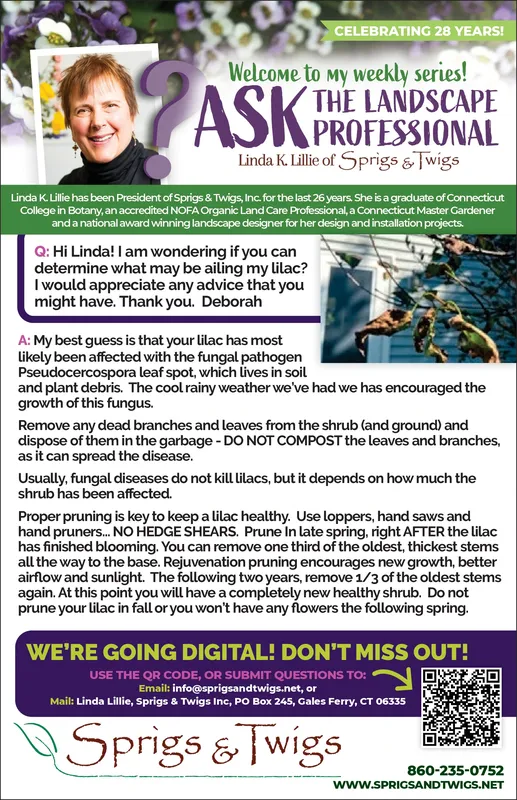Advertisement

-
Published Date
August 25, 2024This ad was originally published on this date and may contain an offer that is no longer valid. To learn more about this business and its most recent offers, click here.
Ad Text
CELEBRATING 28 YEARS! Welcome to my weekly series! THE LANDSCAPE ASK PROFESSIONAL BASK Linda K. Lillie of Sprigs & Twigs Linda K. Lillie has been President of Sprigs & Twigs, Inc. for the last 26 years. She is a graduate of Connecticut College in Botany, an accredited NOFA Organic Land Care Professional, a Connecticut Master Gardener and a national award winning landscape designer for her design and installation projects. Q: Hi Linda! I am wondering if you can determine what may be ailing my lilac? I would appreciate any advice that you might have. Thank you. Deborah A: My best guess is that your lilac has most likely been affected with the fungal pathogen Pseudocercospora leaf spot, which lives in soil and plant debris. The cool rainy weather we've had we has encouraged the growth of this fungus. Remove any dead branches and leaves from the shrub (and ground) and dispose of them in the garbage - DO NOT COMPOST the leaves and branches, as it can spread the disease. Usually, fungal diseases do not kill lilacs, but it depends on how much the shrub has been affected. Proper pruning is key to keep a lilac healthy. Use loppers, hand saws and hand pruners... NO HEDGE SHEARS. Prune In late spring, right AFTER the lilac has finished blooming. You can remove one third of the oldest, thickest stems all the way to the base. Rejuvenation pruning encourages new growth, better airflow and sunlight. The following two years, remove 1/3 of the oldest stems again. At this point you will have a completely new healthy shrub. Do not prune your lilac in fall or you won't have any flowers the following spring. WE'RE GOING DIGITAL! DON'T MISS OUT! USE THE QR CODE, OR SUBMIT QUESTIONS TO: Email: info@sprigsandtwigs.net, or Mail: Linda Lillie, Sprigs & Twigs Inc, PO Box 245, Gales Ferry, CT 06335 Sprigs & Twigs 860-235-0752 WWW.SPRIGSANDTWIGS.NET CELEBRATING 28 YEARS ! Welcome to my weekly series ! THE LANDSCAPE ASK PROFESSIONAL BASK Linda K. Lillie of Sprigs & Twigs Linda K. Lillie has been President of Sprigs & Twigs , Inc. for the last 26 years . She is a graduate of Connecticut College in Botany , an accredited NOFA Organic Land Care Professional , a Connecticut Master Gardener and a national award winning landscape designer for her design and installation projects . Q : Hi Linda ! I am wondering if you can determine what may be ailing my lilac ? I would appreciate any advice that you might have . Thank you . Deborah A : My best guess is that your lilac has most likely been affected with the fungal pathogen Pseudocercospora leaf spot , which lives in soil and plant debris . The cool rainy weather we've had we has encouraged the growth of this fungus . Remove any dead branches and leaves from the shrub ( and ground ) and dispose of them in the garbage - DO NOT COMPOST the leaves and branches , as it can spread the disease . Usually , fungal diseases do not kill lilacs , but it depends on how much the shrub has been affected . Proper pruning is key to keep a lilac healthy . Use loppers , hand saws and hand pruners ... NO HEDGE SHEARS . Prune In late spring , right AFTER the lilac has finished blooming . You can remove one third of the oldest , thickest stems all the way to the base . Rejuvenation pruning encourages new growth , better airflow and sunlight . The following two years , remove 1/3 of the oldest stems again . At this point you will have a completely new healthy shrub . Do not prune your lilac in fall or you won't have any flowers the following spring . WE'RE GOING DIGITAL ! DON'T MISS OUT ! USE THE QR CODE , OR SUBMIT QUESTIONS TO : Email : info@sprigsandtwigs.net , or Mail : Linda Lillie , Sprigs & Twigs Inc , PO Box 245 , Gales Ferry , CT 06335 Sprigs & Twigs 860-235-0752 WWW.SPRIGSANDTWIGS.NET
